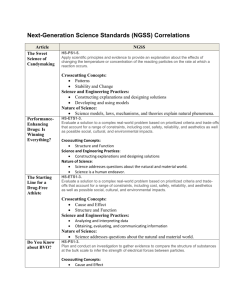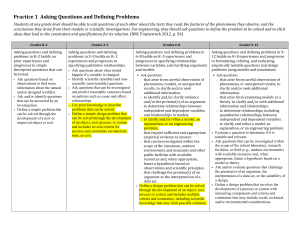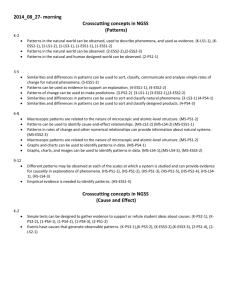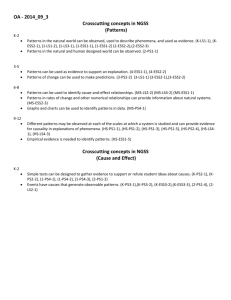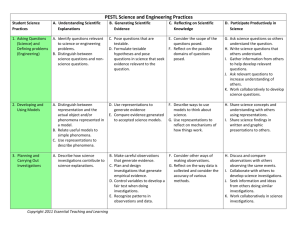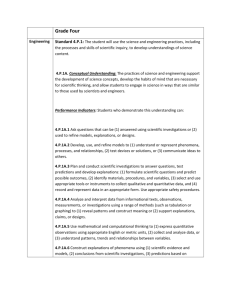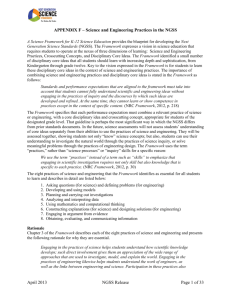Plankton_SciEngPract
advertisement
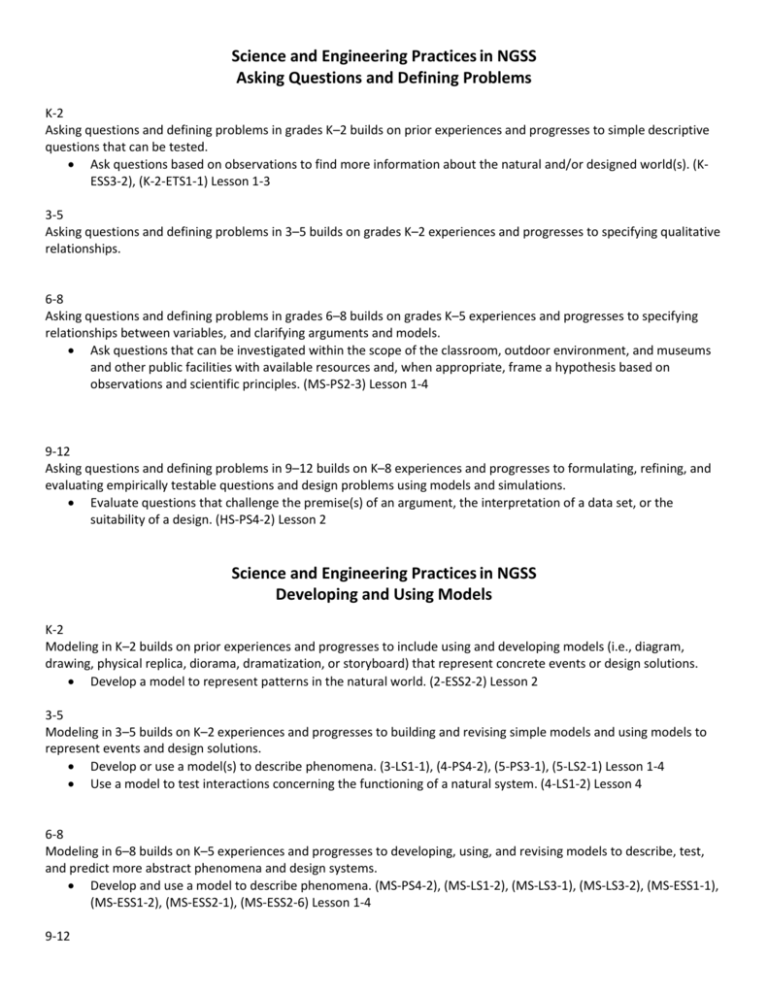
Science and Engineering Practices in NGSS Asking Questions and Defining Problems K-2 Asking questions and defining problems in grades K–2 builds on prior experiences and progresses to simple descriptive questions that can be tested. Ask questions based on observations to find more information about the natural and/or designed world(s). (KESS3-2), (K-2-ETS1-1) Lesson 1-3 3-5 Asking questions and defining problems in 3–5 builds on grades K–2 experiences and progresses to specifying qualitative relationships. 6-8 Asking questions and defining problems in grades 6–8 builds on grades K–5 experiences and progresses to specifying relationships between variables, and clarifying arguments and models. Ask questions that can be investigated within the scope of the classroom, outdoor environment, and museums and other public facilities with available resources and, when appropriate, frame a hypothesis based on observations and scientific principles. (MS-PS2-3) Lesson 1-4 9-12 Asking questions and defining problems in 9–12 builds on K–8 experiences and progresses to formulating, refining, and evaluating empirically testable questions and design problems using models and simulations. Evaluate questions that challenge the premise(s) of an argument, the interpretation of a data set, or the suitability of a design. (HS-PS4-2) Lesson 2 Science and Engineering Practices in NGSS Developing and Using Models K-2 Modeling in K–2 builds on prior experiences and progresses to include using and developing models (i.e., diagram, drawing, physical replica, diorama, dramatization, or storyboard) that represent concrete events or design solutions. Develop a model to represent patterns in the natural world. (2-ESS2-2) Lesson 2 3-5 Modeling in 3–5 builds on K–2 experiences and progresses to building and revising simple models and using models to represent events and design solutions. Develop or use a model(s) to describe phenomena. (3-LS1-1), (4-PS4-2), (5-PS3-1), (5-LS2-1) Lesson 1-4 Use a model to test interactions concerning the functioning of a natural system. (4-LS1-2) Lesson 4 6-8 Modeling in 6–8 builds on K–5 experiences and progresses to developing, using, and revising models to describe, test, and predict more abstract phenomena and design systems. Develop and use a model to describe phenomena. (MS-PS4-2), (MS-LS1-2), (MS-LS3-1), (MS-LS3-2), (MS-ESS1-1), (MS-ESS1-2), (MS-ESS2-1), (MS-ESS2-6) Lesson 1-4 9-12 Modeling in 9–12 builds on K–8 experiences and progresses to using, synthesizing, and developing models to predict and show relationships among variables between systems and their components in the natural and designed worlds. Use a model based on evidence to illustrate the relationships between systems or between components of a system. (HS-LS1-4), (HS-LS1-5), (HS-LS1-7) Lesson 1-4 Science and Engineering Practices in NGSS Planning and Carrying Out Investigations K-2 Planning and carrying out investigations to answer questions or test solutions to problems in K–2 builds on prior experiences and progresses to simple investigations, based on fair tests, which provide data to support explanations or design solutions. Make observations (firsthand or from media) to collect data that can be used to make comparisons. (K-PS3-1), (1-ESS1-2), (2-LS4-1) Lesson 1-3 3-5 Planning and carrying out investigations to answer questions or test solutions to problems in 3–5 builds on K–2 experiences and progresses to include investigations that control variables and provide evidence to support explanations or design solutions. Make observations and/or measurements to produce data to serve as the basis for evidence for an explanation of a phenomenon or test a design solution. (3-PS2-2), (4-PS3-2), (4-ESS2-1), (5-PS1-3) Lesson 1-3 6-8 Planning and carrying out investigations to answer questions or test solutions to problems in 6–8 builds on K–5 experiences and progresses to include investigations that use multiple variables and provide evidence to support explanations or design solutions. Conduct an investigation to produce data to serve as the basis for evidence that meet the goals of an investigation. (MS-PS2-2), (MS-LS1-1) Lesson 1-4 Science and Engineering Practices in NGSS Analyzing and Interpreting Data K-2 Analyzing data in K–2 builds on prior experiences and progresses to collecting, recording, and sharing observations. Use observations (firsthand or from media) to describe patterns in the natural world in order to answer scientific questions. (K-LS1-1), (K-ESS2-1), (1-ESS1-1) Lesson 1-3 3-5 6-8 Analyzing data in 6–8 builds on K–5 experiences and progresses to extending quantitative analysis to investigations, distinguishing between correlation and causation, and basic statistical techniques of data and error analysis. Analyze and interpret data to determine similarities and differences in findings. (MS-PS1-2), (MS-LS4-1), (MSESS1-3), (MS-ESS3-2) (MS-ETS1-3) Lesson 1-4 Analyze and interpret data to provide evidence for phenomena. (MS-LS2-1), (MS-ESS2-3) Lesson 1-4 9-12 Analyzing data in 9–12 builds on K–8 experiences and progresses to introducing more detailed statistical analysis, the comparison of data sets for consistency, and the use of models to generate and analyze data. Analyze data using tools, technologies, and/or models (e.g., computational, mathematical) in order to make valid and reliable scientific claims or determine an optimal design solution. (HS-PS2-1), (HS-ESS2-2) Lesson 4 Science and Engineering Practices in NGSS Using Mathematics and Computational Thinking K-2 Use mathematical and/or computational representations of phenomena or design solutions to describe and/or support claims and/or support explanations. (HS-LS2-1) (HS-ESS1-4) (HS-ESS3-6) Lesson 4 Create or revise a simulation of a phenomenon, designed device, process, or system. (HS-LS4-6) Lesson 4 Science and Engineering Practices in NGSS Constructing Explanations and Designing Solutions K-2 Constructing explanations and designing solutions in K–2 builds on prior experiences and progresses to the use of evidence and ideas in constructing evidence-based accounts of natural phenomena and designing solutions. Make observations (firsthand or from media) to construct an evidence-based account for natural phenomena. (1-PS4-2), (1-LS3-1), (2-PS1-3), Lesson 1-3 3-5 Constructing explanations and designing solutions in 3–5 builds on K–2 experiences and progresses to the use of evidence in constructing explanations that specify variables that describe and predict phenomena and in designing multiple solutions to design problems. Use evidence (e.g., observations, patterns) to support an explanation. (3-LS3-2) Lesson 1-3 Apply scientific ideas to solve design problems. (4-PS3-4) Lesson 2 6-8 Constructing explanations and designing solutions in 6–8 builds on K–5 experiences and progresses to include constructing explanations and designing solutions supported by multiple sources of evidence consistent with scientific ideas, principles, and theories. Apply scientific ideas to construct an explanation for real-world phenomena, examples, or events. (MS-LS4-2) Lesson 4 Construct an explanation that includes qualitative or quantitative relationships between variables that predict phenomena. (MS-LS2-2), (MS-LS4-4) Lesson 4 Undertake a design project, engaging in the design cycle, to construct and/or implement a solution that meets specific design criteria and constraints. (MS-PS1-6) Lesson 2 Science and Engineering Practices in NGSS Engaging in Argument from Evidence K-2 Engaging in argument from evidence in K–2 builds on prior experiences and progresses to comparing ideas and representations about the natural and designed world(s). 3-5 Engaging in argument from evidence in 3–5 builds on K–2 experiences and progresses to critiquing the scientific explanations or solutions proposed by peers by citing relevant evidence about the natural and designed world(s). Make a claim about the merit of a solution to a problem by citing relevant evidence about how it meets the criteria and constraints of the problem. (3-LS4-4), (3-ESS3-1), Lesson 2 6-8 Engaging in argument from evidence in 6–8 builds on K–5 experiences and progresses to constructing a convincing argument that supports or refutes claims for either explanations or solutions about the natural and designed world(s). Evaluate competing design solutions based on jointly developed and agreed-upon design criteria. (MS-LS2-5), (MS-ETS1-2) Lesson 2 Science and Engineering Practices in NGSS Obtaining, Evaluating, and Communicating Information K-2 Obtaining, evaluating, and communicating information in K–2 builds on prior experiences and uses observations and texts to communicate new information. Read grade-appropriate texts and use media to obtain scientific information to determine patterns in the natural world. (1-LS1-2) Read books included with kit Communicate solutions with others in oral and/or written forms using models and/or drawings that provide detail about scientific ideas. (K-ESS3-3) Lesson 2 3-5 Obtaining, evaluating, and communicating information in 3–5 builds on K–2 experiences and progresses to evaluating the merit and accuracy of ideas and methods. Obtain and combine information from books and other reliable media to explain phenomena. (3-ESS2-2), (4ESS3-1), (5-ESS3-1) Lesson 1-3 & books included with kit 9-12 Obtaining, evaluating, and communicating information in 9–12builds on K–8 experiences and progresses to evaluating the validity and reliability of the claims, methods, and designs. Communicate scientific information or ideas (e.g. about phenomena and/or the process of development and the design and performance of a proposed process or system) in multiple formats (including orally, graphically, textually, and mathematically). (HS-LS4-1), (HS-ESS1-3) Lesson 2 Connections to Nature of Science Scientific Investigations Use a Variety of Methods K-2 Science investigations begin with a question. (1-PS4-1) Lesson 1-3 Scientists use different ways to study the world. (K-PS2-1), (K-PS3-1), (1-PS4-1) Lesson 1-3 Science investigations use a variety of methods, tools, and techniques. (3-PS2-1) Lesson 1-3 None 3-5 6-8 9-12 Science investigations use diverse methods and do not always use the same set of procedures to obtain data. (HS-ESS3-5) Lesson 1-4 Scientific inquiry is characterized by a common set of values that include: logical thinking, precision, openmindedness, objectivity, skepticism, replicability of results, and honest and ethical reporting of findings. (HS-LS13) Lesson 1-4 Science Knowledge is Based on Empirical Evidence K-2 Scientists look for patterns and order when making observations about the world. (K-LS1-1), (K-ESS2-1), (1-LS12), (2-LS4-1) Lesson 1-3 Science findings are based on recognizing patterns. (3-PS2-2), (3-LS1-1), (4-PS4-1) Lesson 1-3 Science knowledge is based upon logical and conceptual connections between evidence and explanations (MSPS1-2), (MS-PS1-5), (MS-PS2-2), (MS-PS2-4), (MS-PS3-4), (MS-PS3-5), (MS-PS4-1), (MS-LS1-6), (MS-LS4-1) Lesson 1-4 3-5 6-8 Science Models, Laws, Mechanisms, and Theories Explain Natural Phenomena K-2 3-5 Scientific Knowledge is Open to Revision in Light of New Evidence
